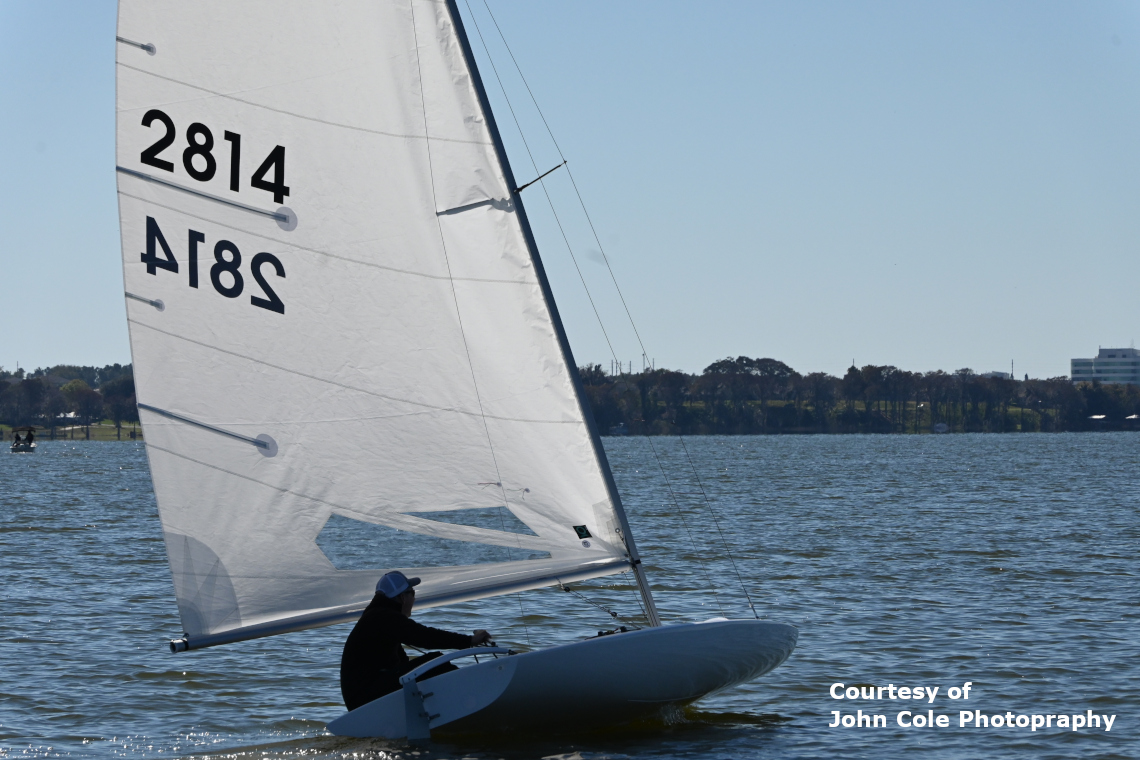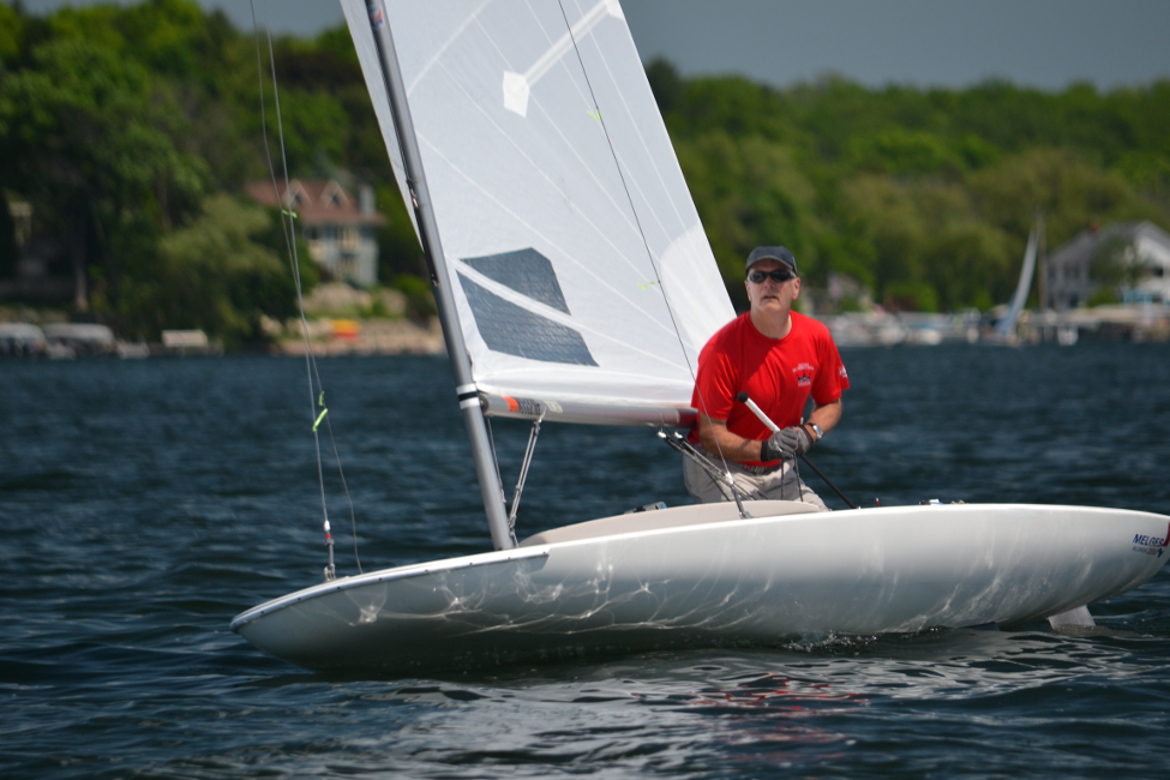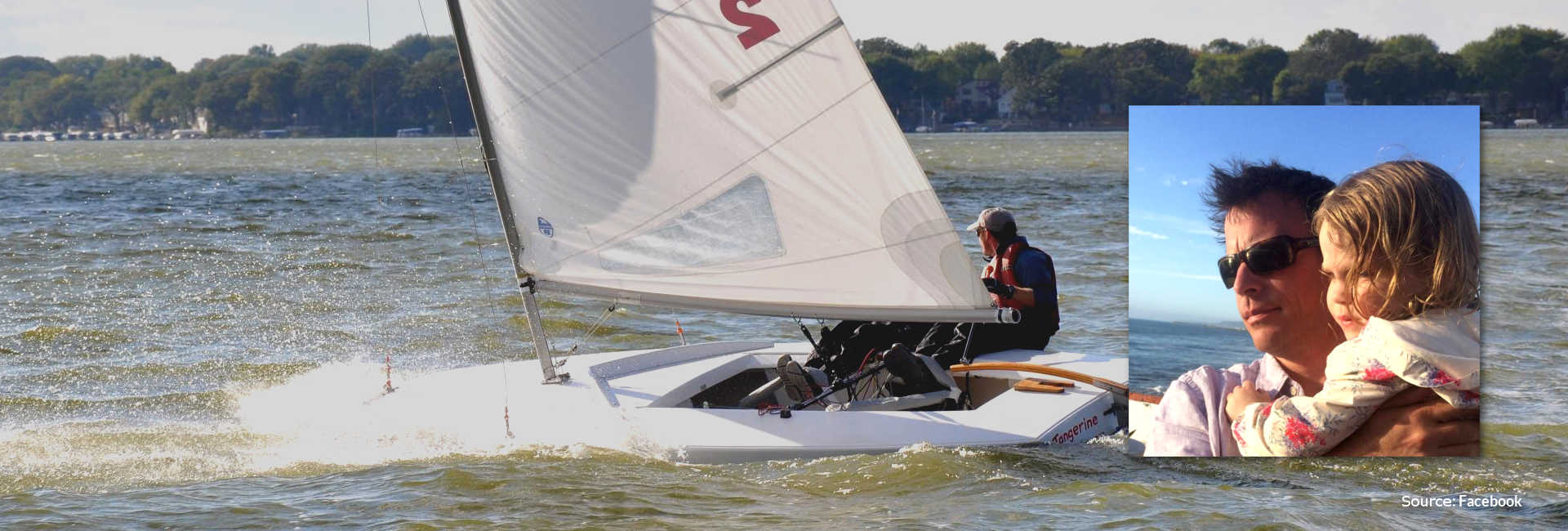Ted Keller won the 45-boat MC Scow Train Wreck regatta held January 28-30, 2022, at Lake Eustis Sailing Club (LESC). Ted is also leading the Triple Crown series at LESC after two events. He graciously agreed to share some racecourse notes.
Day 1
The weather was not what we pictured for a winter getaway to FL, but the fleet was happy to be on the water again. With temps in the low 40’s and a medium yet building breeze, we were in full bundle up mode. My wool hat unfortunately did not make the trip. We sailed three races back-to-back with NNW winds that started around 5 mph and built to 13-15 mph through the afternoon.
Race 1
Race 1 was lighter with a big shift to the left in the last minute before the start. The key was being at the pin end of the line, or in that vicinity, and being able to get on to port as soon as possible after the gun. It looked like that shift was going to hold the entire leg and the boats furthest left would be winning. However, towards the top of the course the wind shifted back to the right and the handful of boats that were further right were able to tack and cross and lead into the mark.
From that point, it was very much pressure driven, trying to line up the next puff coming down the lake. I think it was more often the left side, with a little bit of right shift at the top. Avoiding the fleet of boats coming downwind as you headed back upwind was also important. You had to choose the quickest path to get through the traffic to clear air after the leeward gate. Then you could settle in to sail fast.
Race 2
The breeze then built for Race 2; 13-15 with maybe a bit more in the big puffs. This was the windiest race of the regatta. Getting in to depower mode and still keeping the boat moving were the priorities. Cunningham and outhaul on very hard, vang on hard, and traveler down, and perhaps even pulling the board up a notch, were all effective in settling the boat down. I think a very active mainsheet is also key. Ease, even a lot, to keep the boat from blowing up on its side in the puff. And then trim back in for that turbo boost of forward energy when the boat stays flat.
I like to take small bites, dropping the traveler 2-3″ down to see if that’s enough to stabilize the boat. Lots of sailors drop the traveler 6 inches as soon as the breeze builds. It is a responsive adjustment, where 3 or perhaps 2 inches off centerline may be enough to do the job and still preserve some pointing angle.
Races 1 and 2 were about finding clear lanes and keeping the boat flat and moving forward through the waves. The building breeze meant the shifts came more frequently and it was less about getting to one side of the course and more about sailing the lifted tack.
Race 3
The third race was still pretty windy but was just starting to show signs of lightening up. I had put my crew, Arial Harrington from Lake Eustis, on the boat with me. I sure needed her on the first leg, and we were both hiking hard. But on the first downwind the wind started coming down. The second time upwind we were sitting on the deck instead of feet in the straps. And by the last beat up we were both in the cockpit or Arial to leeward. It’s not a fun feeling when your crew ends up sitting to leeward, but it is part of the deal.
I did not have Arial in the windiest race (Race 2) where crew would have been ideal. I got her on the boat to watch the breeze begin to drop. The important thing was to keep our heads on straight and do all we could to hang on and not lose boats. Try to find the puffs and get in them, sailing in more pressure. We ended up 9th which ended up being OK. It could have been a lot worse.
Day 2
Day 2 saw temps in the low 40’s and breeze blowing 25+. No racing this day.
Day 3
The last day of the regatta saw temps in the 30’s. We needed to hold for an hour just to let the temps get into the low 40’s. We headed out in an 8 mph NW breeze.
I tried to get out to the course and sail upwind a few times to get a feel for what the breeze was doing. It seemed like one side was very favored, much like race 1 and that it would be important to get to a side. But then it would shift the other way. It would hold on each side for 5 or 6 minutes, but then come back the other way.
I decided to be on whatever side of the starting line would be favored at the gun, but make sure I was sailing the lifted tack and not just head to a side. There was predominantly more breeze on the right side. But every time I had a headed angle going right, I’d tack and take a step back towards the center. I was able to get up in the front group and at the top we were coming out of the right side. The top 3 boats at the windward mark came out of the left corner, charging in on port, and rounding ahead of us. It just goes to show you how ‘in flux’ things can be on a long windward leg and a big body of water like Lake Eustis.
From that point I settled in and went to work on the passing boats in front of me. It was important to line up the pressure and go get in it, both upwind and downwind. At the leeward gate, the aim was to pick the rounding that had you on the higher (lifted) angle or sailing towards more pressure. I was also looking for the quickest, cleanest path through the downwind sails to clear air on the other side. Then finding the pressure.
As the race went on, the right became more important, and the front group ended up pretty leveraged to that side just to be in the pressure.
Thanks
Thank you to Al Haeger and his team of volunteers and David Leather and his race committee team. Thank you to my crew Arial Harrington. And thank you to Lake Eustis Sailing Club. See you in March for the Midwinters!
About Ted Keller
TK Sailing (Ted Keller) provides sport boat racing / crewing, regatta preparation, sailing clinics, and individual coaching. His Speed Clinic includes classroom chalk talk, on the water drills, practice racing, and features his ‘Pyramid of Performance’ designed to maximize your racing experience. If you are looking for a dedicated team member for a scow or sportboat event or campaign, please contact him to help you achieve your goals. To find out more, visit the TK Sailing page or e-mail him at ted@melges.com
Related Content
Plan the Next Beat: Ted Keller Comments
Race with Consistency – Ted Keller Comments





